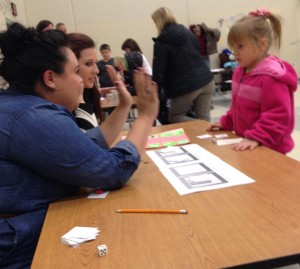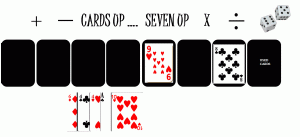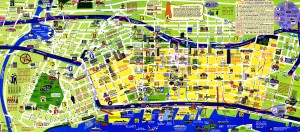
Target Grade: 4th-5th
Concept: Geometric Properties
Procedures: Categorizing, identifying properties of polygons
Common Core State Standards Targeted:
Classify two-dimensional figures based on the presence or absence of parallel or perpendicular lines, or the presence or absence of angles of a specified size. Recognize right triangles as a category, and identify right triangles.
CCSS.MATH.CONTENT.5.G.B
Classify two-dimensional figures into categories based on their properties.
Understand that attributes belonging to a category of two-dimensional figures also belong to all subcategories of that category. For example, all rectangles have four right angles and squares are rectangles, so all squares have four right angles.
Classify two-dimensional figures in a hierarchy based on properties.
Alignment to CCSS:
While the the students are playing this game, they will be using properties of two-dimensional figures to classify and show relationships between the figures. Also, the students will be able to see and understand how attributes belong to subcategories of a category. An example that we used is that acute, obtuse, and right triangles all share the attribute of having interior angles that add up to 180⁰. Also, the students will be able to see how two-dimensional figures are in a hierarchy based on their properties because they will be using Venn Diagrams to assign properties. One example we used for the game was a rectangle and a square. This allows the students to see that they are both quadrilaterals and that a square is just a special type of rectangle.
Mathematical Practices Used:
-
Make sense of problems and persevere in solving them: The students are provided with a situation in which they must accurately solve a problem within a time restraint. The students are unaware of the properties they will need to categorize until the game begins. Upon reading each of the given properties, students will analyze and make sense of what each property is describing, and then determine which category it belongs to.
-
Model with mathematics: The students are able to physically manipulate the game pieces to place them in their proper category on a Venn Diagram. Along with the boards and game pieces, students are physically able to compare and contrast cut outs of the two dimensional shapes. These shapes are then used again when the students are asked to defend and support their findings.
-
Attend to precision: The students must carefully read each property to fully understand what they are each describing. Many of the properties are worded very similarly, but with one significant difference: For example, one property states “The sum of the internal angles equal 360 degrees”, whereas another property states “The sum of the external angles equal 360 degrees”. The students must be able to differentiate between these subtle differences, while dealing with the time restraint.
-
Look for and make use of structure: The students must recognize what each section of the Venn diagram symbolizes in order to determine which section, properties should be placed into. The diagrams of the two-dimensional figures below each of the Venn diagrams depict properties such as right angles and parallel lines. Students may decipher these symbols in order to assist them in categorizing each property.
Technology:
The only use of technology in this activity would maybe be a document camera. This could be used to show how the activity works and what it will look like. Other than that, this is a very hands on activity that mostly uses paper.
Mathematical Modeling Aspects Present in the Activity
-
Realizing when revision need to be made: Students must be able to realize that their answers are incorrect and move the game piece to the proper place on the Venn diagram.
-
Identify important quantities and organize their relationships using such tools as diagrams, two-way tables, graphs, flowcharts and formulas: Students will have to know how to use a Venn Diagram in order to identify properties that pertain to certain polygons. It will be very important for them to know that some of the properties are shared by more than one polygon.
-
Analyze relationships mathematically to draw conclusions: The students will have to be able to analyze the relationships between polygons in order to place the properties in the correct spots on the diagrams. When the student draws a conclusion, that is when they have decided where the property goes on the Venn Diagram and why.
Objective: Students will be able to categorize two-dimensional figures based on their properties using Venn diagrams.
Time: Approximately 30-35 minutes dependent on total number of game rounds.Five minutes for introduction for game rules. One minute per game round. Ten minutes for discussion questions.
Players: One player per Venn diagram poster at a time.
Materials: Venn diagram posters (attached), properties game pieces (attached), timer, whiteboard, and dry-erase markers to keep score.
Label each of the Venn diagrams as follows:
“Square vs. Rectangle”
“Right vs. Obtuse vs. Acute”
“Rectangle vs. Trapezoid”
You may use whatever comparisons you would like for this activity, these are the ones we chose. The attached game pieces correspond to these comparisons.
3 Venn Diagram 2 Venn Diagram PolygonProperties
How to Play:
-
Lay out each game board (Venn diagram poster) throughout the room.
-
Divide the students into even groups(teams) for each available game board.
-
Create a scoring table to record the points for each team.
-
One student from each team will go at a time. When the time begins, the participating student will flip over the game pieces and begin to place and rearrange them on the game board until the minute is up.
-
After the minute has passed, the instructor will go around to each board to count up the number of correct placements of game pieces to determine the number of points.
-
Each correct placement is equal to one point. Record the points for each team.
-
Repeat steps 4-6 until each student from each team has completed their board.
-
Teams will then rotate to the next board, and repeat steps 4-7 until each team has completed each board.
-
Count the total number of points for each team to determine the winner.
Adaptations:
This activity can easily be modified for students at a wide range of grade levels. For example, instead of using a Venn Diagram, you can use a T chart and cut outs of different shapes to have younger students seperate them out into triangles and rectangles. This was a good activity for Kindergarten, 1st, and maybe 2nd grade. Also, asking that age group why they know which shapes are rectangles and which shapes are triangles was very beneficial.
This activity can also be modified for older students. This could easily be set up for a high school geometry class. One modification would be to use very specific properties for shapes such as hexagons, heptagons, and so on. Another way to raise the difficulty would be to use three and four way Venn Diagrams. This would really allow the students to demonstrate their knowledge of the relationships between different polygons.
Discussion Questions:
-
What strategy did you use to get the properties in the correct place?
-
What did you get wrong? Why?
-
Why is it important to know about different shapes?
-
Where can this knowledge be used in real life?
-
What more would you like to learn about polygons?
Wrap Up:
The wrap up will be very important to the students because it will allow them the opportunity to put into words their strategies, struggles, and successes. By students discussing the activity, they will be able to see connections they may have missed during the activity and make the ideas and concepts more concrete. Also, this is a great time to clear up any questions or concerns from the students. In addition, the wrap up is a great time to informally exam assess your students and get feedback for the next time you do this activity.







